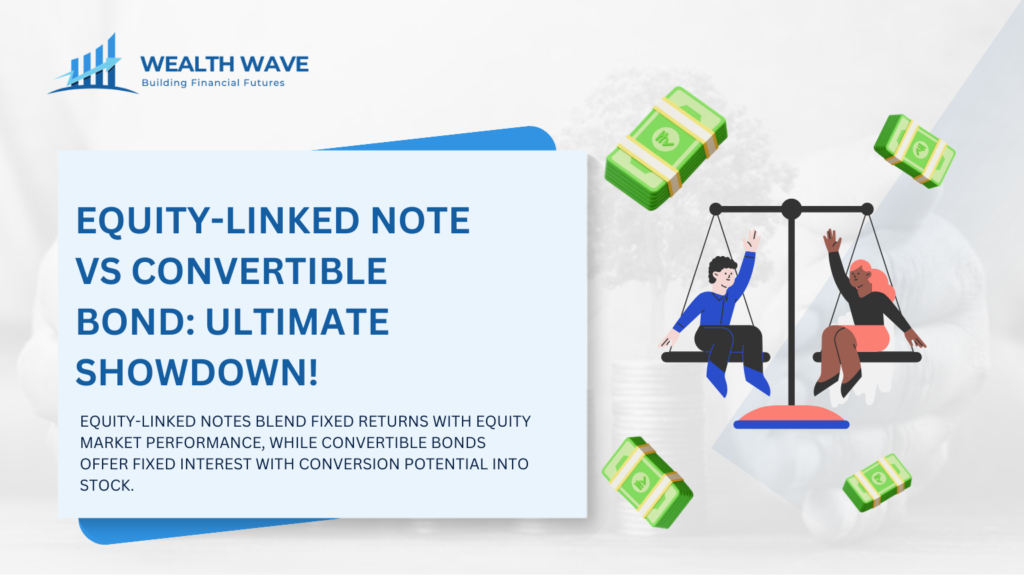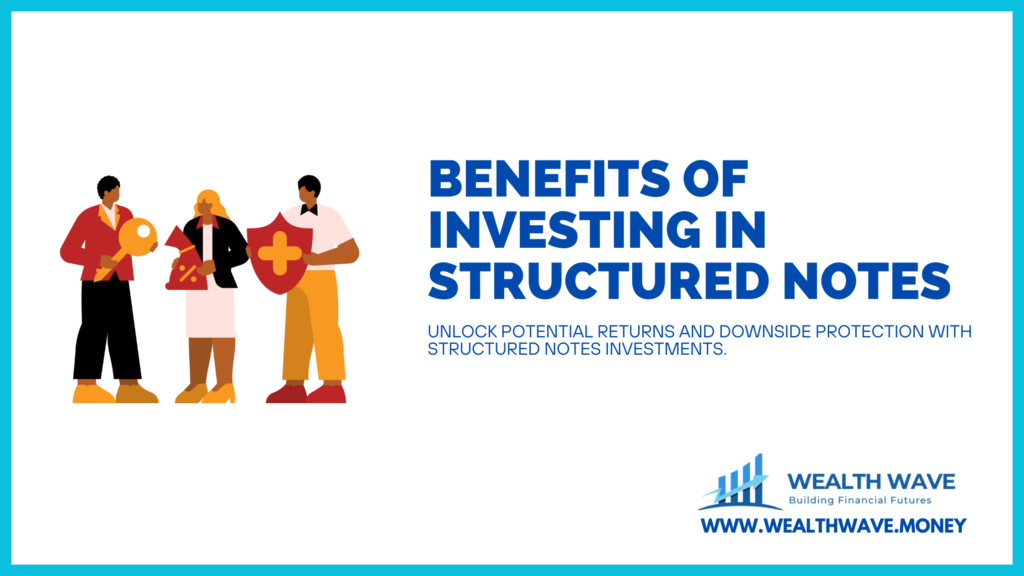
Choosing between equity-linked note Vs convertible bond can feel like navigating through a maze. Notes also offer intriguing pathways for investors eager to explore beyond the realm of traditional stocks or bonds, yet the abundance of financial terms and concepts can turn decision-making into quite the challenge.
We understand because we’ve navigated this maze ourselves, weighing every option with careful consideration. What caught our attention was the unique nature of convertible bonds – debt securities with a magical twist: they can transform into common stock or equity shares.
This discovery propelled us into an in-depth exploration, seeking to understand every nook and cranny of these investment vehicles.
Our journey revealed that ELNs and convertible bonds each come with their own set of benefits and risks, tailored to meet diverse investment appetites. In this article, we’ll unpack everything from how ELNs tick to breaking down the various flavors of convertible bonds – all designed to arm you with knowledge so you can make choices that resonate with your investment goals.
Ready for a deep dive? Let’s get started!
Key Takeaways
- Equity-linked notes (ELNs) and convertible bonds both allow investors to convert into equity, but they have different structures and risks. ELNs often come with principal protection and leverage for higher returns, while convertible bonds mix fixed income with the option to convert into shares.
- Convertible bonds work well for startups by providing a way to attract investment without heavy debt burdens, offering interest payments and potential equity growth. ELNs target investors looking for growth plus a degree of income security through their link to underlying equities or indices.
- Choosing between ELNs and convertible bonds depends on one’s risk tolerance, investment goals, and the current interest rate environment. While ELNs may offer higher potential returns in low-interest scenarios, convertible bonds provide stability with conversion prospects in rising rate conditions.
- Understanding the specific features, benefits, risks of each option helps investors make informed decisions tailored to their financial strategies.
Overview of Equity-Linked Notes (ELN)

Equity-Linked Notes provide a unique way to invest in the stock market. They combine value of the debt instruments and equity, allowing investors to link their returns to specific stocks or indices.
Definition of ELN

Equity-linked notes (ELNs) are structured products that combine features of both debt and equity. We see them as a type of debt instrument that offers the potential for an above-average return compared to regular bonds.
These notes provide principal protection and can leverage our investment for higher total return potential. Many ELNs can trade on exchanges, enhancing their liquidity. They operate by linking their returns to the performance of underlying equities or equity indices.
This connection makes them attractive for investors seeking growth while maintaining some fixed income characteristics.
Features of ELN

Equity-linked notes (ELNs) come with unique features that make them appealing as an investment product. These structured notes offer the potential for an above-average return compared to traditional fixed income investments.
Equity-Linked Notes are typically issued by companies looking to attract investors with a blend of fixed income and equity exposure. These notes are designed to provide returns based on the performance of underlying equity markets.
ELNs provide principal protection, which means we can safeguard our initial investment. They also allow us to employ leverage, increasing our chances of higher total returns.
We find ELNs to be exchange-traded, making them accessible in the market. They represent a hybrid between debt and equity options, offering a blend of fixed interest rate benefits and equity risk exposure.
Yet, like all investments, equity-linked notes carry certain risks that we must consider. Understanding these features prepares us for a deeper look at how ELNs operate.
How ELN Operates

We understand how equity-linked notes (ELNs) function. An ELN combines features of both debt and equity. This investment allows us to participate in the potential upside of an underlying stock while receiving a fixed income.
As we invest in an ELN, our principal is often protected, giving us peace of mind.
The investment pays interest, and we have the option to convert it into equity at a later date. This flexibility lets us potentially achieve higher returns than traditional bonds. While ELNs carry certain risks, they can be exchange-traded, making them accessible for various investors.
Ultimately, ELNs can enhance our investment portfolio by blending fixed-income security with equity growth.
Benefits of ELN
Equity-linked notes (ELNs) offer several benefits that attract investors. They provide the potential for above-average returns when compared to regular bonds. We appreciate that ELNs come with principal protection, which secures our investment.
The leverage they employ enhances our total return potential. We can also trade equity-linked notes on exchanges, adding to their appeal. These features make ELNs an attractive option in our asset allocation strategy.
As we consider convertible bonds next, we can explore how these fixed-income securities function and their unique advantages.
Risks of ELN
Equity-linked notes (ELNs) come with several risks that we must consider. While ELNs offer potential for higher returns, they also carry market risk. If the underlying equity performs poorly, we may not see the expected returns.
ELNs typically provide principal protection, but this may not be guaranteed in all market conditions.
Liquidity risk is another concern. We may find it difficult to sell our ELNs at a favorable price when we need cash flow. Additionally, changes in interest rates can impact the value of our investment.
Understanding these risks helps us make informed choices between equity-linked notes and other securities like convertible bonds.
Overview of Convertible Bonds

Convertible bonds offer investors a unique blend of fixed-income security and equity potential. These instruments can convert into number of shares, allowing us to benefit from stock price increases while enjoying the safety of traditional bonds.
Definition of Convertible Bonds
Convertible bonds are fixed-income debt securities that we can convert into common stock or equity shares. These bonds blend features of debt and equity financing. They pay interest, just like traditional bonds.
Investors enjoy the potential for capital appreciation when they convert their bonds into equity. Convertible notes play a crucial role, especially for startups. They help these companies get their operations up and running while offering a way to attract investors.
This hybrid nature makes convertible bonds an appealing choice for many investors looking for equity and options.
How Convertible Bonds Work
Convertible bonds act as fixed-income debt securities. Investor may receive regular interest income during the bond’s life. We can convert these bonds into common stock or equity shares, giving us flexibility.
This feature allows us to benefit from company growth. Convertible bonds present a hybrid of debt and equity financing. They provide us a chance to get involved in a company’s success while still earning interest.
Some types of convertible bonds include straight, contingent, and mandatory conversions.
Investors need to weigh the advantages and risks of convertible bonds carefully. They pay interest, but the conversion feature adds complexity to their valuation. The relationship between equity performance and bond value is significant.
Next, we will explore the different types of convertible bonds and their advantages.
Types of Convertible Bonds
Convertible bonds come in several types, each serving different investor needs. Standard convertible bonds allow us to exchange the bond for common stock at specified prices. We also find mandatory convertible bonds, which force conversion into stock at a certain date. Convertible Bonds are debt instruments that can be converted into common stock of the issuer at a specified conversion ratio. This feature allows investors to benefit from the issuer’s equity upside
For those interested in fixed-income options, convertible preferred stocks stand out. These provide steady interest payments while also offering conversion into common shares.
Another option includes contingent convertible bonds, which convert only under specific conditions. This type helps manage risk for investors. Each of these types serves unique purposes in the conversation around equity-linked notes vs convertible bonds.
Both types of securities are held until maturity, but their underlying structures differ significantly. Convertible Bonds have a maturity date where investors can choose to convert their bonds into stock or receive the principal.
Understanding these options aids us in making better investment choices.
Advantages of Convertible Bonds
Convertible bonds offer several advantages. They allow us to enjoy fixed income while also having the option to convert into common stock. This feature provides potential for significant equity growth, especially if the company performs well.
We find that convertible bonds can attract interest from both risk-averse investors and those looking for equity exposure. They typically pay interest, giving us regular income.
Another benefit includes the ability to minimize downside risk. If the stock does not perform as expected, we still hold a debt security that pays interest. Convertible bonds are also flexible.
They act as a hybrid investment, merging debt and equity financing. This unique characteristic enhances their appeal, especially in uncertain market conditions. We can consider both equity-linked notes and convertible bonds in our investment strategy for better risk management.
Risks of Convertible Bonds
Convertible bonds carry specific risks. They may appear attractive due to their fixed-income nature and potential to convert into equity shares. Market fluctuations can negatively impact their value, especially if the stock price falls below the conversion price.
If the company struggles, it might not repay the debt.
Interest rate changes also pose risks. Rising rates can lead to falling bond prices, affecting our returns. Convertible bonds are hybrids of debt and equity financing, which means they can be volatile.
Investors must weigh these risks against the advantages. Understanding convertible bonds helps us make informed decisions about our investments.
Equity-Linked Note Vs Convertible Bond

Equity-linked notes and convertible bonds both offer unique features for investors. We can analyze their similarities and differences to understand which option suits us better based on our financial goals.
Similarities and Differences
Equity-linked notes (ELNs) and convertible bonds share similarities as both fall under the category of equity-linked securities. They provide an opportunity to convert into equity, offering potential upside for investors.
We can think of convertible bonds as a mix of debt and equity financing. They pay interest while giving holders the option to convert to common stock. Both instruments carry risks, but they present unique advantages and challenges.
Differences arise mainly in their structure and function. ELNs typically offer principal protection and leverage, aiming for higher total returns compared to traditional bonds. In contrast, convertible bonds focus on fixed-income debt with conversion options, making them less risky than ELNs.
While convertible bonds guarantee interest payments, ELNs do not. We must weigh the pros and cons when choosing between these investment options.
Pros and Cons of Each Investment Option
Equity-linked notes (ELNs) offer several benefits. They provide the potential for an above-average return compared to regular bonds. We enjoy the principal protection and leverage employment that ELNs offer.
This leads to higher total return potential. Investors should remain aware of the risks associated with ELNs. Market volatility can impact returns.
Convertible bonds also present advantages. They pay interest and can be converted into equity shares. This hybrid finance approach benefits startups seeking funds. We should weigh these positives against the risks.
Market conditions can affect the value of convertible bonds. Ultimately, both convertible bonds and ELNs come with pros and cons. Evaluating these options helps us understand our best investment path.
Factors to Consider When Choosing Between ELNs and Convertible Bonds

When we choose between ELNs and convertible bonds, we need to assess our investment goals. We should also evaluate our risk tolerance and how interest rates may affect each option.
Investment Goals
We must define our investment goals clearly. Equity-linked notes (ELNs) provide an opportunity for above-average returns compared to regular bonds. ELNs offer principal protection, which appeals to many investors. Investors should understand that the value of Equity-Linked Notes will fluctuate with the performance of the underlying equity markets, while Convertible Bonds offer a more stable fixed interest until maturity.
They also come with leverage, allowing us to maximize our returns. On the other hand, convertible bonds serve a different purpose. They can help startups begin their operations by offering fixed-income debt securities that convert into equity shares.
Identifying what we want from our investments is key. If we seek higher returns and protection, ELNs might be our best choice. However, if we prefer a mix of debt and equity financing, convertible bonds can be beneficial.
Both options carry risks, so we need to weigh the pros and cons. Understanding our risk tolerance will guide us in choosing between equity-linked notes and convertible bonds.
Risk Tolerance
Risk tolerance plays a crucial role in choosing between equity-linked notes (ELNs) and convertible bonds. Equity-linked notes carry certain risks, including market fluctuations. They provide the potential for above-average returns, which may attract those willing to face market volatility.
On the other hand, convertible bonds offer fixed-income characteristics. They pay interest and are less volatile than ELNs.
Our risk tolerance impacts our investment decisions. For those seeking significant returns, ELNs may suit best. If we prefer stability with the option to convert to equity, convertible bonds might be the right choice.
Each investment option carries its pros and cons, making it essential to assess our comfort with risk before deciding.
Interest Rate Environment
The interest rate environment plays a significant role in our investment choices between equity-linked notes (ELNs) and convertible bonds. Currently, lower interest rates make ELNs attractive.
These notes provide the potential for above-average returns compared to regular bonds. They also offer principal protection and leverage employment, making them appealing in today’s market.
Convertible bonds pay interest, adding to their appeal as fixed-income securities. Investors often prefer convertible bonds when interest rates rise. Higher rates can increase the conversion value of these bonds into common stock or equity shares, benefiting us in the long run.
Both equity-linked notes and convertible bonds carry risks, but understanding the interest rate landscape helps us make informed decisions.
Company Analysis
We must analyze the company before choosing between equity-linked notes and convertible bonds. Company analysis helps us understand the financial health and growth potential of the business. Issuing convertible bonds can be an attractive option for companies seeking to raise capital while offering investors the potential to convert their bonds into equity.
We should look at revenue trends, market position, and management quality. Equity-linked notes often link to strong companies that show promise. This can enhance the return potential compared to regular bonds.
Convertible bonds fit well for startups. These firms can leverage convertible notes to finance operations while limiting debt. They benefit from converting bonds into equity. This reduces the debt burden and allows growth.
Both equity-linked notes and convertible bonds carry risks, so a thorough company analysis is crucial for informed investment decisions.
Conclusion

We reviewed the differences between equity-linked notes and convertible bonds. Both offer unique advantages and potential risks. ELNs can provide higher returns, while convertible bonds offer fixed income with conversion options.
Choosing the right option depends on our investment goals and risk appetite. We can find valuable resources online for deeper insights into these securities. Let’s take action and explore our options for smarter investing.
FAQs
Q1. What is the main difference between an equity-linked note and a convertible bond?
Ans. The key difference lies in how these financial derivatives operate. An equity-linked note is a type of derivative security that pays interest, but its final value links to an underlying stock option. A convertible bond, on the other hand, can be converted into shares of the issuing company stock.
Q2. How does bond valuation factor into these two types of securities?
Ans. Bond valuation plays a crucial role in both cases as it determines their initial pricing. However, with an equity-linked note, changes in the linked stock's price affect the final payout while for convertible bonds; it influences whether or not conversion to stocks happens.
Q3. Are there any unique risks associated with investing in either an equity-linked note or a convertible bond?
Ans. Yes, both carry specific risks tied to market fluctuations and individual company performance since they are forms of Equitylinked securities. Investors must carefully consider these factors before investing.
Q4. Can you explain more about how financial derivatives like equity-linked notes and convertible bonds work?
Ans. Sure! Financial derivatives get their value from underlying assets - such as stocks for equity-linked notes and bonds for convertible bonds – hence their namesake 'derivative'. They offer investors different ways to earn returns based on market movements and company performance.




